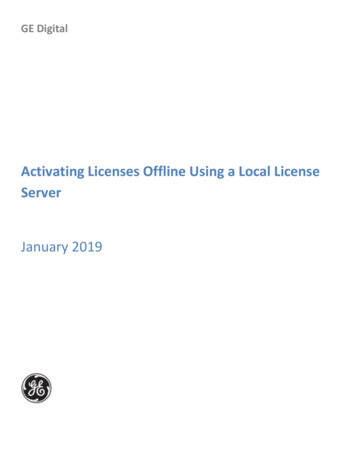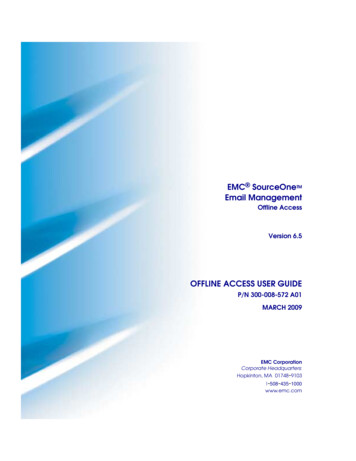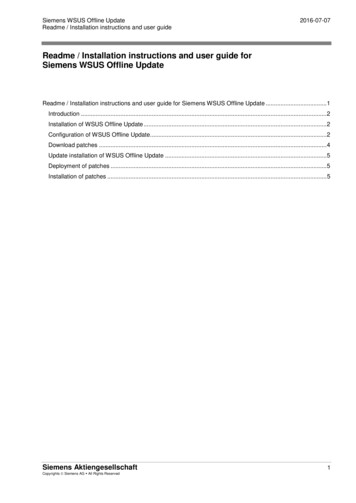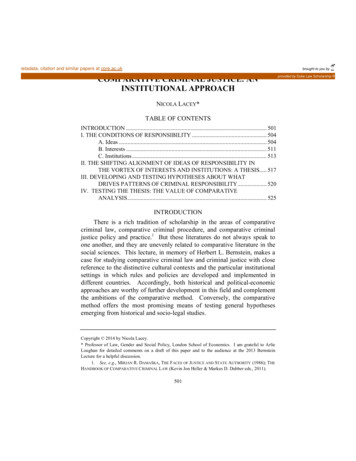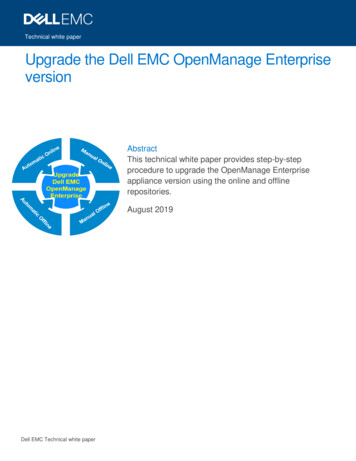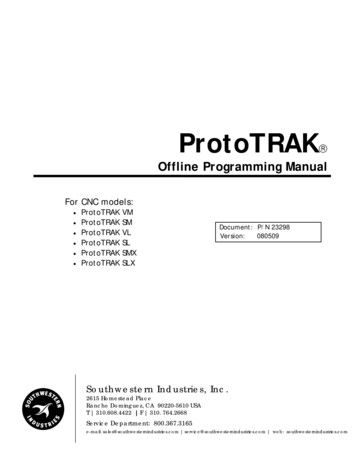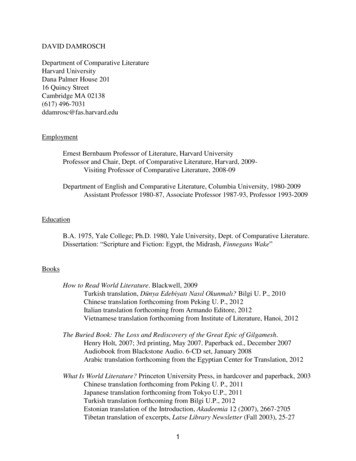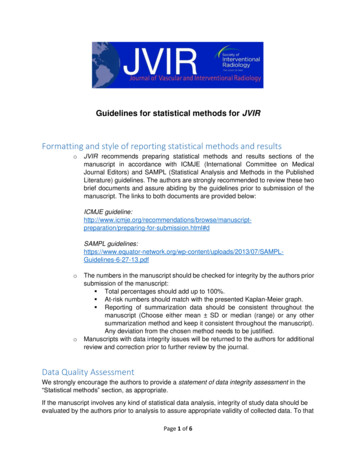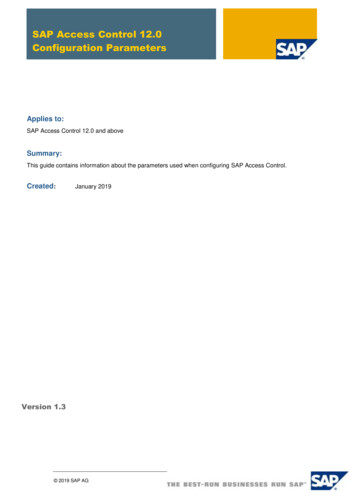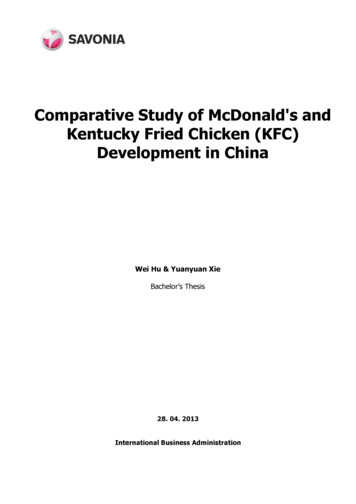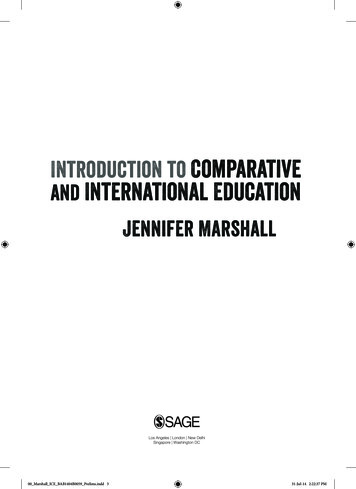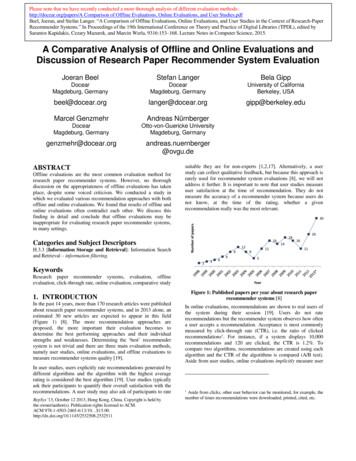
Transcription
Please note that we have recently conducted a more thorough analysis of different evaluation methods:http://docear.org/papers/A Comparison of Offline Evaluations, Online Evaluations, and User Studies.pdfBeel, Joeran, and Stefan Langer. “A Comparison of Offline Evaluations, Online Evaluations, and User Studies in the Context of Research-PaperRecommender Systems.” In Proceedings of the 19th International Conference on Theory and Practice of Digital Libraries (TPDL), edited bySarantos Kapidakis, Cezary Mazurek, and Marcin Werla, 9316:153–168. Lecture Notes in Computer Science, 2015.A Comparative Analysis of Offline and Online Evaluations andDiscussion of Research Paper Recommender System EvaluationJoeran BeelStefan LangerBela GippDocearMagdeburg, GermanyDocearMagdeburg, GermanyUniversity of CaliforniaBerkeley, duMarcel GenzmehrAndreas NürnbergerDocearMagdeburg, GermanyOtto-von-Guericke UniversityMagdeburg, .deOffline evaluations are the most common evaluation method forresearch paper recommender systems. However, no thoroughdiscussion on the appropriateness of offline evaluations has takenplace, despite some voiced criticism. We conducted a study inwhich we evaluated various recommendation approaches with bothoffline and online evaluations. We found that results of offline andonline evaluations often contradict each other. We discuss thisfinding in detail and conclude that offline evaluations may beinappropriate for evaluating research paper recommender systems,in many settings.suitable they are for non-experts [1,2,17]. Alternatively, a userstudy can collect qualitative feedback, but because this approach israrely used for recommender system evaluations [8], we will notaddress it further. It is important to note that user studies measureuser satisfaction at the time of recommendation. They do notmeasure the accuracy of a recommender system because users donot know, at the time of the rating, whether a givenrecommendation really was the most relevant.30Number of papersABSTRACTCategories and Subject DescriptorsH.3.3 [Information Storage and Retrieval]: Information Searchand Retrieval – information filtering.16129234611918142016115KeywordsResearch paper recommender systems, evaluation, offlineevaluation, click-through rate, online evaluation, comparative studyYearFigure 1: Published papers per year about research paperrecommender systems [8]1. INTRODUCTIONIn the past 14 years, more than 170 research articles were publishedabout research paper recommender systems, and in 2013 alone, anestimated 30 new articles are expected to appear in this field(Figure 1) [8]. The more recommendation approaches areproposed, the more important their evaluation becomes todetermine the best performing approaches and their individualstrengths and weaknesses. Determining the ‘best’ recommendersystem is not trivial and there are three main evaluation methods,namely user studies, online evaluations, and offline evaluations tomeasure recommender systems quality [19].In user studies, users explicitly rate recommendations generated bydifferent algorithms and the algorithm with the highest averagerating is considered the best algorithm [19]. User studies typicallyask their participants to quantify their overall satisfaction with therecommendations. A user study may also ask of participants to rateaRepSyssingle'13,aspectof 12a recommendersystem,instance,howbynovelOctober2013, Hong Kong,China.forCopyrightis heldorauthoritative therecommendedresearchpapers are, or howthe owner/author(s).Publicationrights licensedto ACM.ACM 978-1-4503-2465-6/13/10 15.00.http://dx.doi.org/10.1145/2532508.2532511In online evaluations, recommendations are shown to real users ofthe system during their session [19]. Users do not raterecommendations but the recommender system observes how oftena user accepts a recommendation. Acceptance is most commonlymeasured by click-through rate (CTR), i.e. the ratio of clickedrecommendations1. For instance, if a system displays 10,000recommendations and 120 are clicked, the CTR is 1.2%. Tocompare two algorithms, recommendations are created using eachalgorithm and the CTR of the algorithms is compared (A/B test).Aside from user studies, online evaluations implicitly measure user1Aside from clicks, other user behavior can be monitored, for example, thenumber of times recommendations were downloaded, printed, cited, etc.
satisfaction, and can directly be used to estimate revenue ifrecommender systems apply a pay-per-click scheme.Offline evaluations use pre-compiled offline datasets from whichsome information has been removed. Subsequently, therecommender algorithms are analyzed on their ability torecommend the missing information. There are three types ofoffline datasets, which we define as (1) true-offline-datasets, (2)user-offline-dataset, and (3) � originated in the field of collaborativefiltering where users explicitly rate items (e.g. movies) [18]. Trueoffline-datasets contain a list of users and their ratings of items. Toevaluate a recommender system, some ratings are removed, and therecommender system creates recommendations based on theinformation remaining. The more of the removed ratings therecommender predicts correctly, the better the algorithm. Theassumption behind this method is that if a recommender canaccurately predicted some known ratings, it should also reliablypredict other, unknown, ratings.In the field of research paper recommender systems, users typicallydo not rate research articles. Consequently, there are no trueoffline-datasets. To overcome this problem, implicit ratingscommonly are inferred from user actions (e.g. citing, downloading,or tagging a paper). For instance, if a user writes a research paperand cites other articles, the citations are interpreted as positivevotes of the cited articles [3]. To evaluate a recommender system,the articles a user has cited are removed from his authored paper.Then, recommendations are generated (e.g. based on the text in theauthored paper) and the more of the missing citations arerecommended the more accurate the recommender is. Instead ofpapers and citations, any other document collections may beutilized. For instance, if users manage research articles using areference management software, such as JabRef or Zotero, some(or all) of the users’ articles could be removed andrecommendations could be created using the remaininginformation. We call this type of dataset ‘user-offline-dataset’because it is inferred from the users’ decision whether to cite, tag,store, etc. an article.The third type of datasets, which we call ‘expert-offline-datasets’,are those created by experts. Examples of such datasets includeTREC or the MeSH classification. In these datasets, papers aretypically classified by human experts according to informationneeds. In MeSH, for instance, terms from a controlled vocabulary(representative of the information needs) are assigned to papers.Papers with the same MeSH terms are considered highly similar.For an evaluation, the information need of the user must bedetermined and the more of the papers satisfying the informationneed are recommended, the better.In contrast to user studies and online evaluations, offlineevaluations measure the accuracy of a recommender system.Offline datasets are considered a ground-truth that represents theideal set of papers to be recommended. For instance, in theprevious example, we assumed that the articles an author cites arethose articles to be best recommended. Thus, the fewer of theauthor-cited articles are predicted by the recommender system, theless accurate it is. To measure accuracy, precision at position n(P@n) is typically used to express how many of the relevantarticles were recommended within the top n results of therecommender. Other common evaluation metrics include recall, Fmeasure, mean reciprocal rank (MRR) and normalized discountedcumulative gain (NDCG). Only MRR and NDCG take into accountthe position of recommendations in the generated recommendationlist. For a comprehensive overview of offline evaluations includingevaluation metrics and potential problems refer to [4,18,19].Typically, offline evaluations are meant to identify the mostpromising recommendation approaches [5,6,19]. These mostpromising approaches should then be evaluated in more detail witha user study or an online evaluation to identify the best approaches.However, we found that most approaches are only evaluated withoffline evaluations [8], rendering the results one-sided. In addition,some arguments have been voiced that offline-evaluations are notadequate to evaluate recommender systems [6,9,17]. Researchindicates that offline evaluations and user studies sometimescontradict each other [7,8,13]. This means, algorithms thatperformed well in offline evaluations did not always perform wellin user studies. This is a serious problem. If offline evaluationscould not reliably predict an algorithm’s performance and hencecannot fulfill their purpose in a user study or an online evaluation,the question arises what they are good for.2. RESEARCH OBJECTIVE &METHODOLOGYInitial comparisons of user studies and offline evaluations, in thefield of research paper recommender systems, were mostly notvery sound because user studies contained relatively fewparticipants [8]. The studies also did not examine whether theresults of offline evaluations and online evaluations correlated. Thelimited discussion that does exist focused on recommender systemsin general [9–13] that were not developed for research paperrecommendations in particular.Therefore, we conducted a comprehensive evaluation of a set ofalgorithms using (a) an offline evaluation and (b) an onlineevaluation. Results of the two methods were compared todetermine whether and when results of the two evaluation methodscontradicted each other. Subsequently, we discuss differences andvalidity of evaluation methods focusing on research paperrecommender systems. The goal was to identify which of theevaluation methods were most authoritative, or, if some methodsare unsuitable in general. By ‘authoritative’, we mean whichevaluation method one should trust when results of differentmethods contradict each other.We performed both evaluations using the literature managementsoftware Docear, a desktop software for Windows, Linux, andMacOS, which we developed [14]. Docear manages electronicliterature and references in mind maps and offers a recommendersystem for research papers. Weekly, or upon user request, therecommender system retrieves a set of research papers fromDocear’s server and recommends them to users. Typically, one setcontains ten recommendations2. When a user clicks on arecommendation, this is recorded. For information on Docear’srecommendation approaches refer to [15]. For information onDocear’s users refer to [21].2For some recommendation approaches coverage was low. In these cases,less than ten recommendations were made.
With the consent of Docear’s recommendation service users,Docear has access to: the mind maps containing text, citations, and links topapers on the users’ hard drivesthe papers downloaded as a PDFthe annotations created directly in the PDF files, i.e.comments, highlighted text, and bookmarksthe BibTeX references created for further use in, e.g.,Microsoft Word or LaTeX.Docear’s recommender system selects randomly out of severalfactors to create an algorithm to generate recommendations.Among the factors that are randomly chosen are stop-word removal(on/off); feature type (citations or text); number of mind maps toanalyze (only the current mind map or the past x created/edited/maps); feature weighting scheme (TF only; several TF-IDFvariations); and many additional factors. This way, one randomlyassembled algorithm might utilize terms in the currently editedmind map with the terms being weighted by TF only, while anotheralgorithm utilizes citations made in the last 5 created mind maps,with the citations weighted by TF-IDF (i.e. CCIDF [16]).For the online evaluation, 57,050 recommendations were deliveredto 1,311 users. The primary evaluation metric was click-throughrate (CTR). We also calculated mean average precision (MAP)over the recommendation sets. This means, for each set ofrecommendations (typically ten), the average precision wascalculated. For example, when two of ten recommendations wereclicked, average precision was 0.2. Subsequently, the mean wascalculated over all recommendation sets of a particular algorithm.information than MAP and thus variations in the results should belower.In some cases, the offline evaluation had predictive power for analgorithm’s performance in Docear. Docear randomly selects theuser model size, i.e. the number of terms that represent the user’sinterests. In the offline evaluation, precision increased with thenumber of terms a user model contained – up until 26-100 terms(Figure 2). For larger user models, precision decreased. CTR alsoincreased the more terms a user model contained and decreasedonce the user model became too large; although for CTR, themaximum was achieved for 101-250 terms. Figure 2 clearly showsa high correlation between offline and online evaluation. Even theabsolute results are comparable in many cases. For instance, for auser model size of 101-250 terms CTR was 7.21% and P@10 was7.31%.Docear randomly selects whether to keep term weights for thematching process of user models and recommendation candidates.This means, after terms with the highest weight have been stored inthe user model, Docear uses the terms either with or without theirweight to find papers that contain the same terms. Again, theoffline evaluation satisfactorily predicts results of the onlineevaluation (Figure 3).12%10%8%6%4%2%0%For the offline evaluation, we removed the paper that was lastdownloaded from a user’s document collection together with allmind maps and mind map nodes that were created by the user afterdownloading the paper. An algorithm was randomly assembled togenerate ten recommendations and we measured therecommender’s precision, i.e. whether the recommendationscontained the removed paper. Performance was measured asprecision3 at rank ten (P@10). The evaluation was based on 5,021mind maps created by 1,491 users.3. RESULTSMAP and CTR coincide highly for all evaluated algorithms.Whether terms or citations (Figure 7), the weighting schemes(Figure 4), user model size (Figure 2), or the number of analyzednodes (Figure 5), both CTR and MAP never contradicted eachother4. Since MAP is based on CTR this finding is not a surprise,however, to our knowledge this has not been shown empiricallybefore. This finding also implies that there is no need to report bothmetrics in future papers. While reporting either metric is sufficient,CTR is probably preferable, since CTR makes use of more1CTR23456-10112526100101- 251- 501250 500 10002.42% 2.49% 2.50% 0.97% 3.13% 6.06% 5.29% 6.75% 7.21% 6.64% 5.63%MAP 3.27% 2.50% 2.63% 1.07% 3.45% 6.02% 5.30% 6.73% 7.01% 6.85% 5.48%p@10 0.32% 1.07% 1.93% 2.97% 3.13% 4.63% 7.41% 9.87% 7.31% 3.53% 2.36%User Model Size (Number of Terms)Figure 2: Impact of user model size (number of 16.13%13.69%MAP16.13%13.69%p@1014.03%11.51%Term weights utilized for matchingFigure 3: Storing term weights34In addition to precision, we also measured mean reciprocal rank (MRR)and normalized discounted cumulative gain (NDCG). However, resultsdid not differ notably from precision. Hence, due to space restrictions,these results are omitted.It could still be possible that MAP over users will differ.To calculate term weights, the offline evaluation is not aspredictive. On the one hand, both offline and online evaluationsshow that a TF-IDF weighting based on a user’s mind mapsperforms best (Figure 4). On the other hand, the offline evaluationshows a little but significantly better performance for a TF-onlyweight than for a TF-IDF measure based on the entire corpus. The
online evaluation contradicts the offline evaluation, with TF-IDFon the corpus performing better than TF-only.In many other situations, offline evaluations could not predict analgorithm’s performance in practice, i.e. in a real-word systemmeasured with CTR. We will only present some of the results dueto space restrictions.Docear randomly selects how many of the most recently x created,edited, or moved nodes in a mind map are utilized (from each ofthe x nodes, the contained terms are used to construct the usermodel). The offline evaluation predicts that performance is best foranalyzing the 50-99 most recently edited, created, or moved nodes(Figure 5). If more nodes were analyzed, precision stronglydecreased. However, in practice analyzing the most recent 5001000 nodes achieved the highest CTR (9.21%) and adding morenodes only slightly decreased CTR.terms from the user’s mind maps and recommended those papersthat frequently contain the extracted terms. For citation-basedrecommendations, Docear extracted the most frequent citationsfrom the users’ mind maps, and those research papers thatfrequently contain the same citations were recommended(comparable to CCIDF [16]). For term-based recommendations,the offline evaluation predicted a precision of 5.57%, which wasquite accurate – the actual CTR was 6.34% (Figure 7). For citationbased recommendations, however, the offline evaluation predicteda disappointing result of 0.96%. In practice, the citation-basedapproach had a CTR of 8.27% and thus even outperformed thetext-based approach. If one had relied on offline evaluations, oneprobably had not considered trying citations in practice becausethey performed so poorly in the offline evaluation.12%11%10%9%8%7%6%5%4%In some cases, offline evaluations contradicted results obtained bythe online evaluation. The offline evaluation predicted thatanalyzing only edited nodes would achieve the best performancewith a precision of 5.59% while analyzing moved nodes wouldonly achieve a precision of 4.08% (Figure 6). In practice, resultsdid not coincide. Analyzing moved nodes resulted in the bestperformance, with a CTR of 10.06% compared to CTR of 6.28%for analyzing edited 5.39%5.59%4.65%4.08%Node Selection MethodFigure 6: Node selection method16%TF OnlyTF-IDF (MM)TF-IDF @105.16%5.79%5.00%4%0%Weighting SchemesFigure 4: Feature weightingTerms OnlyCitations zed Features12%Figure 7: Terms vs. citations8%4%0% 910-4950-99100499500999 .72%# of nodes being analyzedFigure 5: Number of utilized nodesFor the fundamental question of whether to utilize terms orcitations for generating recommendations, results also differed. Forterm-based recommendations, Docear extracted the most frequentDocear is open to both registered and unregistered users5. Theoffline evaluation predicted that recommendations for anonymoususers would achieve higher performance (P@10 6.98%) than forregistered users (4.36%). This is interesting in itself. Apparently,there must be significant differences in the mind maps created by5Registered users have a user account tied to their email address. All mindmaps created by users who wish to receive recommendations areuploaded to Docear’s server, where they are analyzed. For users whowant to receive recommendations but do not want to register, an‘anonymous’ user account is automatically created. These accounts havea unique random ID and all mind maps of these users are uploaded toDocear’s server.
anonymous and registered users. However, in practice, registeredusers achieve significantly higher CTR (7.35%) compared toanonymous users (4.73%) (Figure 8). This again shows that offlineevaluations could not predict true system performance.3.1 DiscussionIt is commonly assumed that once the most promising algorithmshave been determined via offline evaluations they should beevaluated in detail with user studies or online evaluations.However, our research showed that offline evaluations could notreliably predict an algorithm’s click-through performance inpractice. Instead, offline evaluations were only sometimes able topredict CTR, which leads us to formulate three .73%MAP8.03%5.02%p@104.36%6.98%User TypeFigure 8: User types1. Why do offline evaluations only sometimes accuratelypredict performance in real-world systems?We see two possible answers why offline evaluations may not(always) have predictive power.The first reason, which is also discussed in the literature [17], maybe the ignorance of human factors. Offline evaluations can onlyevaluate the accuracy of recommender systems. However, there arefurther factors – the human factors – influencing whether users aresatisfied with recommender systems and click recommendations orrate them positively. Users may be dissatisfied with accuraterecommender systems, if they must wait for too long to receiverecommendations [18], the presentation is unappealing [19],labeling of recommendations is suboptimal, or recommendationsare given for commercial reasons [20]6. User satisfaction may alsodiffer by demographics – older users tend to be more satisfied withrecommendations than younger users [21].An influence of human factors seems likely for some of ourexperiments, especially when comparing registered vs. unregisteredusers. We would assume that unregistered users are moreconcerned about privacy and tend to refuse an analysis of theirprivate mind maps. Hence, we would expect unregistered users tohave lower acceptance rates of recommendations, i.e. lower CTRs.6Identical recommendations, which were labeled once as organic and onceas commercial, influenced user satisfaction ratings despite having equalrelevance.The analysis of CTR indicates that this assumption is valid.Anonymous users had lower CTRs than registered users. However,the offline evaluation predicted the contrary, namely that registeredusers had lower CTRs. It seems plausible to us that the offlineevaluation was wrong because it could not consider the humanfactors, which might be quite strong in this particular experiment.In other experiments, e.g., when we compared user model sizes,offline evaluations had some predictive power. This may be thecase, because the influence of human factors was the same fordifferent user model sizes or not relevant at all.The second reason why offline-evaluations may not always havepredictive power relates to the imperfection of offline-datasets.Offline-datasets represents a ground-truth that contains all and onlythose papers relevant for recommendations. To compile a validground-truth, users would have to be aware of the entire literaturein their field. Consequently, one must conclude that user-offlinedatasets are incomplete, containing only a fraction of all relevantdocuments and maybe even some papers of low or no relevance.In case of user-offline-datasets based on citations, this problembecomes even more apparent. Many papers contain only fewreferences because of space limitations. As such, citations do notmake an ideal ground-truth because the dataset will never containall relevant papers. This means, even if authors were aware of allrelevant literature – which they are not – they would only add alimited amount of the relevant articles to their document collection(e.g. by citing them).When incomplete datasets are used as ground-truth, recommendersystems are evaluated based on how well they can calculate anincomplete ground-truth. Recommender systems that wererecommending other but equally relevant papers, which happenedto not be contained in the incomplete offline dataset, would receivea poor rating. A recommender system might even recommendpapers of higher relevance than those in the offline dataset, but theoffline evaluation would also give the algorithm a poor rating. Inother words, if the incomplete status quo – that is a documentcollection compiled by researchers, who are not aware of allliterature and are restricted by space and time constraints – is usedas ground-truth, a recommender system can never perform betterthan the imperfect status quo.The inherent citation bias further enforces unsuitability of citationsfor use in offline evaluations. Authors cite papers for variousreasons, and these do not always relate to the paper’s relevance tothat author [22–24]. Some researchers prefer citing the most recentpapers to show they are “up-to-date” in their field, even if the citedpapers are not the most relevant. Other authors tend to citeauthoritative papers because they believe this makes their papermore authoritative, or because it is the popular thing to do. In othersituations, researchers already have in mind what they wish to writebut require a reference to back up their claim. In this case, theytend to cite the first-best paper they find that supports the claim,although there may have been more fitting papers to cite. Thismeans, even if authors were aware of all relevant literature in theirfield, they will not always select the most relevant literature to cite.
This again leads to incomplete and biased document collections,which results in suboptimal evaluations.7The argument of incomplete and biased offline-datasets mayexplain why offline evaluations only sometimes have predictivepower. A correlation between offline and online evaluations wouldoccur when a suboptimal dataset had the same effect on allevaluated algorithms. If the suboptimal dataset had different effectson two algorithms, the offline evaluation would deliver differentresults than an online evaluation.2. Is it possible to identify the situations where offlineevaluations have predictive power?If one could identify the situations in which human factors have thesame or no impact on two algorithms, offline evaluations could bepurposefully applied in these situations. In scenarios like ouranalysis of registered vs. anonymous users, it is apparent thathuman factors may play an important role and offline evaluationsshould not be used. For some of our other experiments, such aswhether to utilize terms or citations, we can see no plausibleinfluence of human factors (but still results did not correlate). Wedoubt that researchers will ever be able to determine reliably inadvance whether human factors play such an important role thatoffline evaluations would not have predictive power. Agreeingwith this assumption, and assuming that the sole purpose of offlineevaluations was to predict CTR or the relevance ratings of users,the only solution was to abandon offline evaluations entirely.The same conclusion applies for the argument regardingincomplete datasets. Retrospectively, one may be able to explainwhy an offline evaluation could not predict the performance inpractice, due to incompleteness of the dataset. However, we doubtthat there could ever be a way to determine in advance if an offlinedataset is incomplete or when suboptimal datasets have the samenegative effects on two algorithms. Therefore, if one accepts thatoffline datasets inferred from users’ data are incomplete and maybeeven biased, and that one cannot determine to what extent datasetsare incomplete and biased, the conclusion can only be to avoidoffline evaluations when evaluating research paper recommendersystems.3. Is it problematic, that offline evaluations do not (always)have predictive power?Theoretically, it could be that results of offline evaluations havesome inherent value, and it might make sense to apply an algorithmin practice, or use it as a baseline, if it performed well in an offlineevaluation although it received low CTR or user ratings. Thisscenario requires that users who compile the offline dataset have abetter knowledge of document relevance than those users therecommendations are shown to.In the case of expert-datasets, one might argue that topical expertscan better judge research paper quality and relevance than average7In the case of a citation recommender, one may argue that biased citationbased evaluations are acceptable because others would also like to cite thesame papers. However, there is still the problem that a citation list isincomplete and a recommender system is punished in an offlineevaluation when it recommends other possibly more relevant papers,which the user may even have preferred to cite.users and hence know better what is relevant to users than the usersthemselves. Therefore, evaluations using expert-datasets mighthave some inherent value and might be more authoritative thanresults obtained from online evaluations or user studies. Forinstance, if experts were asked to compile an introductory readinglist on recommender systems for bachelor students, they couldprobably better select the most relevant documents than thebachelor students themselves could. Even if users were notparticularly satisfied with the recommendations, and rated thempoorly, the recommendations would still have the highest level oftopical relevance to users.However, such an expert-created list for bachelor students may notbe suitable for PhD students who wanted to investigate the topic ofrecommender systems in more depth. Thus, another expert listwould be needed for the PhD students; another for seniorresearchers; another for foreign language students, etc. Overall,there would be an almost infinite number of lists required to caterto all types of user backgrounds and information needs. Such acomprehensive dataset does not exist and probably never will.When today’s expert-datasets are used for evaluations, anevaluation focuses only on one very specific use-case that neglectsthe variety of uses-cases in real applicati
offline datasets, which we define as (1) true-offline-datasets, (2) user-offline-dataset, and (3) expert-offline-datasets. 'True-offline-datasets' originated in the field of collaborative filtering where users explicitly rate items (e.g. movies) [18]. True-offline-datasets contain a list of users and their ratings of items. To
